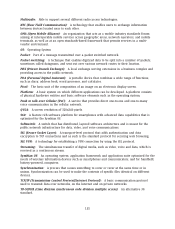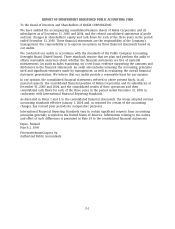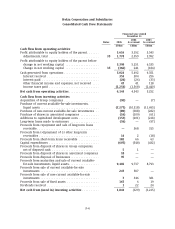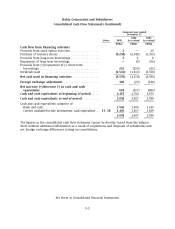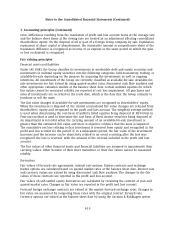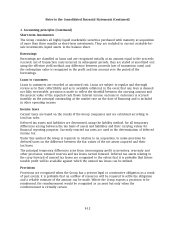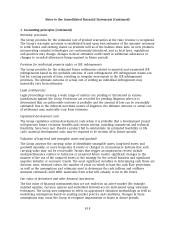Nokia 2005 Annual Report Download - page 147
Download and view the complete annual report
Please find page 147 of the 2005 Nokia annual report below. You can navigate through the pages in the report by either clicking on the pages listed below, or by using the keyword search tool below to find specific information within the annual report.Notes to the Consolidated Financial Statements (Continued)
1. Accounting principles (Continued)
Principles of consolidation
The consolidated financial statements include the accounts of Nokia’s parent company (‘‘Parent
Company’’), and each of those companies in which it either owns, directly or indirectly through
subsidiaries, over 50% of the voting rights, or over which it has control of their operating and
financial policies. The Group’s share of profits and losses of associated companies (generally 20%
to 50% voting rights or over which the Group has significant influence) is included in the
consolidated profit and loss account in accordance with the equity method of accounting.
All inter-company transactions are eliminated as part of the consolidation process. Minority
interests are presented separately in arriving at the net profit and they are shown as a component
of shareholders’ equity in the consolidated balance sheet.
Profits realized in connection with the sale of fixed assets between the Group and associated
companies are eliminated in proportion to share ownership. Such profits are deducted from the
Group’s equity and fixed assets and released in the Group accounts over the same period as
depreciation is charged.
The companies acquired during the financial periods presented have been consolidated from the
date on which control of the net assets and operations was transferred to the Group. Similarly the
result of a Group company divested during an accounting period is included in the Group accounts
only to the date of disposal.
Goodwill
Acquisitions of companies are accounted for using the purchase method of accounting. Goodwill
represents the excess of the purchase cost over the fair value of assets less liabilities of acquired
companies.
The Group assesses the carrying value of goodwill annually or, more frequently, if events or
changes in circumstances indicate that such carrying value may not be recoverable. If such
indication exists the recoverable amount is determined for the cash-generating unit, to which
goodwill belongs. This amount is then compared to the carrying amount of the cash-generating
unit and an impairment loss is recognized if the recoverable amount is less than the carrying
amount. Impairment losses are recognized immediately in the profit and loss account.
Transactions in foreign currencies
Transactions in foreign currencies are recorded at the rates of exchange prevailing at the dates of
the individual transactions. For practical reasons, a rate that approximates the actual rate at the
date of the transaction is often used. At the end of the accounting period, the unsettled balances
on foreign currency receivables and liabilities are valued at the rates of exchange prevailing at the
year-end. Foreign exchange gains and losses arising from balance sheet items, as well as fair value
changes in the related hedging instruments, are reported in Financial Income and Expenses.
Foreign Group companies
In the consolidated accounts all items in the profit and loss accounts of foreign subsidiaries are
translated into euro at the average foreign exchange rates for the accounting period. The balance
sheets of foreign Group companies are translated into euro at the year-end foreign exchange rates
with the exception of goodwill arising on the acquisition of a foreign company prior to the
adoption of IAS 21 (revised 2004) as of January 1, 2005, which is translated to euro at historical
F-9


